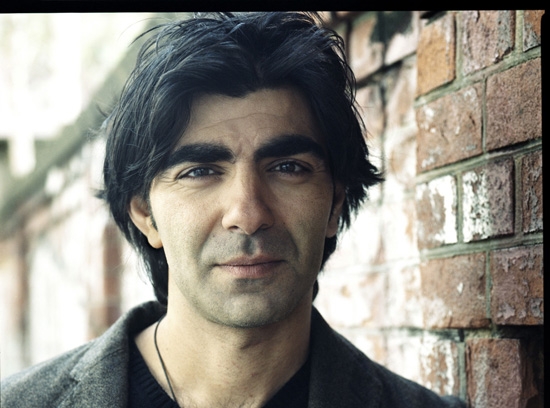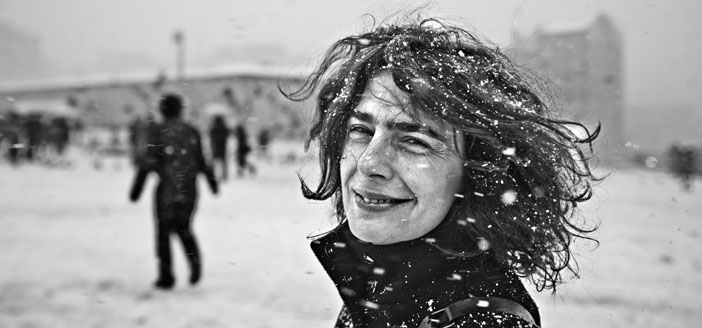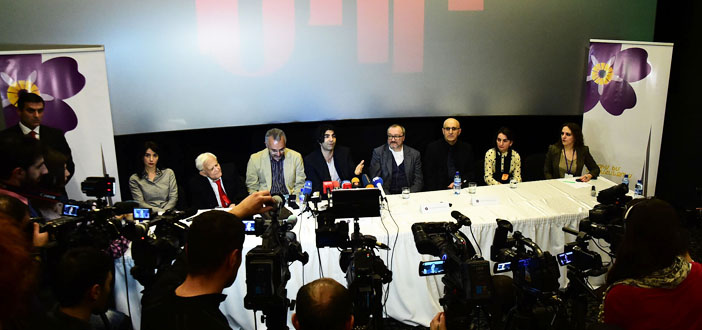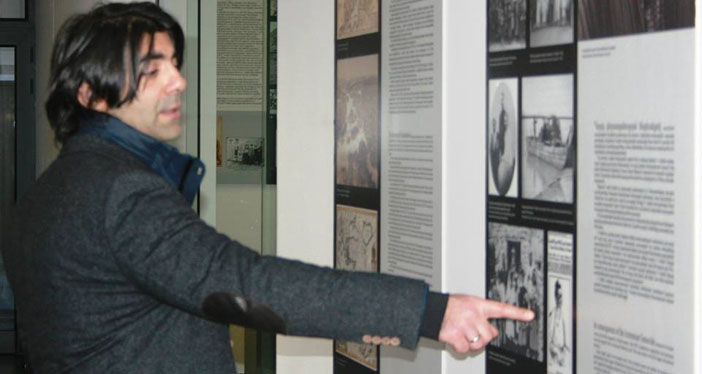‘The Cut’, shot by Fatih Akın in four continents, with a large budget, will premiere at the Venice Film Festival held from 27 August to 6 September. Akın, as always, spoke frankly in this first interview about the film, and stated that his greatest wish was for the film to be screened in major theatres in Turkey.
EVRİM KAYA
evrimkaya@agos.com.tr
The first time we interviewed Fatih Akın for Agos was in Yerevan four years ago. He was attending the International Golden Apricot Film Festival and it hadn’t been long since he had landed, so his impressions were few. As we spoke, he realized he didn’t know much either about Armenians or Armenia; the only famous Armenians he could recall were the two world-champion boxers of Armenian origin who lived in Germany. Yet Yerevan greeted Fatih Akın with excitement. For instance, a young woman at the reception of a hotel that had welcomed many world famous stars since it served as host to the festival every year, hoped for the first time to be there for the arrival of a guest, and tried to find out from other participants the time Akın would arrive. Fatih Akın’s films were met with great enthusiasm in Yerevan, and he underlined the meaninglessness of borders in every interview he gave, and talked about how art could shatter all taboos and bring people together. What he said was right, however such statements did not go beyond the well-meaning responses to questions about the Armenian Genocide or the Armenia-Turkey border. The question of method remained unanswered. How would art overcome everything? As answers were sought for all these questions, the director, from which we had not heard from, whether about this specific topic or any other, returned to the spotlight in April with the first reports from his new film.
According to Time Out Istanbul’s report, Fatih Akın’s latest film ‘The Cut’ is about “the journey an Armenian living in Mardin, played by Tahar Rahim, sets out on in order to find his daughters following a tragedy that befalls him”. However, as we are quite sure the publication’s editor also knows, the tragedy that “befell” Nazaret, played by Tahar Rahim, was the Armenian Genocide.
‘The Cut’, shot by Fatih Akın in four continents, with a large budget, will premiere at the Venice Film Festival held from 27 August to 6 September. Rahim is accompanied in the film by a multinational cast including Armenian actors Simon Abkarian, Arsinée Khanjian and Kevork Malikyan, Akın Gazi from Cyprus, Numan Acar from Germany, the Moroccan singer and poet Hindi Zahra, and Önder Çakar and Bartu Küçükçağlayan from Turkey.
Perhaps, to some extent, to alleviate the confusion of the media in Turkey which is not particularly skilful in calling tragedies by their name, but mainly in order to provide the freshest news for Fatih Akın fans who impatiently look forward to his new film, we asked the director everything we were curious about, after all, we, too, have only seen the trailer of the film. Akın, as always, spoke frankly in this first interview about the film, and stated that his greatest wish was for the film to be screened in major theatres in Turkey.
In the interview we made four years ago, you told us that you knew very little about Armenians. That has obviously changed. How did you decide to make a film about 1915 and Armenians?
After ‘Soul Kitchen’ I had actually planned to make a feature film about Hrant Dink. I wrote a script based on 12 of Hrant’s articles published in Agos. It was an avant-garde project, because some of these articles were informative, some were his personal anecdotes and some others were narratives about 1915. It was a very text-rich script. I don’t know whether it would have turned out to be a good film. However, I couldn’t convince any actor from Turkey to accept the role of Hrant, they all found the script too strong. So I had to put the project in the freezer. I didn’t want to put any actor at risk, but it was also important that a film about Hrant would be a Turkish film. An American or French actor couldn’t have been cast as Hrant. We have to deal with this alone. So it wasn’t to be… Maybe not yet. Some of the articles Hrant wrote on 1915 were highly fascinating, and very powerful in visual terms. For instance, ‘Lizard Abdullah’… Also through Hrant, I had read and carried out a lot of research on 1915. There was another script I dreamed of realizing: A story about Anatolian emigrants to the United States. In a way, a Western. Eventually, I combined certain parts from the Hrant script with this Western, and the result is “The Cut”.
It is very exciting that you wrote the script of the film in collaboration with the Iraqi Armenian scriptwriter Mardik Martin who co-wrote the scripts some of Martin Scorsese’s legendary films like ‘Mean Streets’, ‘New York, New York’, ‘Raging Bull’. How did this collaboration and writing process come about?
I had written the script in German. When I decided to shoot the film in English, I realized I needed someone who could do more than translate the film from German into English. I needed an American scriptwriter; someone who also knew the subject matter, and the languages and customs of this region. Then the name Mardik Martin sprang to my mind. Scorsese’s team arranged a meeting for us. The first time I called Mardik he didn’t want to do it, he told me he had retired and hadn’t written a script in 30 years. But when he read ‘The Cut’ he fell for it. He said he had dreamed all his life for a film like this! However, he said that the script needed more than being translated into ‘American’. He changed the script, personalized it, condensed and improved it. He made it more ‘American’, in the positive sense of the word. Finally, with this film, I am also reflecting upon American cinema, which was the greatest influence on my formation. Particularly Scorsese’s cinema – to which Mardik Martin made a great contribution. Working with Mardik enriched my life in so many ways. This was a journey towards the roots of everything that mattered to me, things about cinema and things about life. Mardik is the most elderly friend I have. And he is a teacher to me.
It is difficult for me to describe the entire writing process; it is too complex to describe in a few sentences. Castro once said revolution has three main characteristics: 1. Observation 2. Planning 3. Action. This also serves as the best description of the writing process. Of course, this film is not a revolution, nor is it revolutionary. Yet perhaps every act of writing is a personal revolution.
I met with hundreds of people across the world who helped me in my research. I would like to name two of them: Wolfgang Gust, who, like me, lives in Hamburg, and Taner Akçam. The scientific works of these two researchers were the most important source for the film.
The trailer reveals Tahar Rahim as a very good choice for a character who retreats into silence. How did you cast the film?
As I always do, I tried to find the best actors for this film, too. In order to capture the necessary authenticity, I tried to cast Armenians in the roles of Armenian characters. But I didn’t restrict myself only to Armenians. I wanted to work with the singer and poet Hindi Zahra. Zahra is Moroccan, but in the film she plays the wife of the protagonist Nazaret, played by Tahar Rahim. As for Rahim, the moment I saw Jacques Audiard’s ‘A Prophet’ I said, “this is the man I am looking for”. Tahar is a French actor of Algerian origin. I gave him this role because all my instincts told me, “This is your hero, this is the Armenian you are looking for! Wherever he is from, he will pull it off for you.” There are no strict rules, water will flow and find its way. I am also very happy with the Turkish actors I had the chance to work with. Bartu Küçükçağlayan is in a key role… Bartu fulfilled his role with great commitment, passion and intelligence. And on the other hand, he possesses such innocence… The fact that he is a musician also contributes to that. My friend Önder Çakar, who wrote the Turkish dialogues, also stars. There are also Turks from Germany like Numan Acar, Korkmaz Arslan and Mehmet Yılmaz, and Akın Gazi, a British citizen of Cypriot origin. Meanwhile, I definitely want to cast Akın as Yılmaz Güney one day.
The cinematographer is once again Rainer Klausmann, but in this film he seems to have surpassed even his own usual mastery. Where did you shoot the film?
We didn’t want to have some ethnic world music that always begins with the sound of the duduk in the background either. Our music for the film was Heavy Metal, because the stories I told were Heavy Metal.
The key motif of the film is the journey of the hero. I traversed the entire span of this journey myself as well, I travelled through Turkey, Syria, Lebanon, Cuba, Florida, Minneapolis and North Dakota and took thousands of photographs and took notes. Finding the right filming locations was a long and complicated process. In the end, we decided upon Jordan, Cuba, Canada, Malta and Germany. Both Rainer and I were using an anamorphic lens to shoot cinemascope for the first time. And of course, 35 mm! It was a dream. This film is the real thing! On some days I used to think: “Somebody pinch me, I can’t believe this is real”. Because the lenses of this camera are very heavy, we worked with only two lenses; we used one of them for close-ups, and the other to shoot the remaining scenes. Since the film takes place across a broad landscape, we mostly used a wide-angle lens and this brought a certain sobriety to the film, a classical mood. We made an effort to always shoot with the sun behind us. We tried to stick to a classical style on the one hand, but we also tried to avoid clichés both in image and sound on the other. We didn’t use tacky techniques like a sepia tone filter. And none of that ethno-world music either, with every song beginning with the sound of the duduk. Our music for the film was Heavy Metal, because the stories I am telling here are Heavy Metal.
At Agos we have been discussing recently why a film that does justice to the story of 1915 has not been made yet. There are some great films, for instance, about the Holocaust. Are there any films about the Armenian Genocide that left a mark on you, or served as a reference?
I don’t see my film as a film about genocide. What would a film about genocide be like? What are the rhetorical tools of such a genre? Or, for that matter, is there a genre we could call ‘genocide films’? The genre I chose was the Western. This is a film in the genre appropriated by Sergio Leone and of course, Eastwood, it is an adventure film. It is an epic, in the tradition of John Huston and David Lean… It does not belong to the tradition of ‘Schindler’s List’ or ‘The Killing Fields’. Atom Egoyan did lend me a few costumes, but I can’t say it has a lot to do with ‘Ararat’ either. The greatest inspiration for this film was Elia Kazan’s ‘America, America’. I have read here and there that this film, too, has been described as a genocide film in the past, but I would disagree. In my opinion, ‘America, America’ is both an epic and an adventure film at the same time.
Why was it important for you to make this film? You had previously said, “I am completing the triangle of love-death-evil”. In the trailer, there is a scene where Tahar Rahim silently responds to a question with only his gaze: “Who did this to you?” Do you have an answer?
Sometimes I feel the topic chose me rather than me seeking out the topic. Wherever I come across something which has been banned or made into a taboo, or has been labelled dangerous or caused controversy, it immediately attracts my attention. Wherever there is prohibition, there is fear. And fear is the Devil. This film treats the outcome of fear in an abstract manner. The devil is not outside there, it sneaks into us. In other words, it is already there. Only we can exorcise him. My answer to, “Who did this to you?”, the question the old man poses to Tahar in the desert, is “Fear.”
This film will also mean that the audiences in Turkey will face up to the darkest page of their history, as they enter the year 2015. There are those who are looking forward to see the film with curiosity, but there are also those who are waiting with fear. Is there anything you would like to tell them?
Towards the end of the music video of Michael Jackson’s “Thriller”, Jackson’s girlfriend starts to scream in terror. Then MJ suddenly appears before her and tells her, “It’s just a movie”. If there is anyone who is afraid of the film, my response to them is precisely that, “It’s just a movie”. But I am sure that society in Turkey, of which I, too, am a part of, is ready for this film. There is no doubt that a film of this kind must be intense, otherwise we wouldn’t take it seriously. But the news we watch every night is much more intense than the film. There will be some who feel uncomfortable about the film’s content. Yet precisely for this reason, I believe the film will offer an opportunity for a constructive debate and I hope it will encourage its audience to learn more about 1915 and to think how a repeat of such events can be prevented.
The interview we made four years ago ended like this: “The message of my work is always this: Wherever there are borders, let us remove them, against the wall, gegen die Wand! And if they cannot be removed, let us build bridges. Politics always has precedence over culture and sports. Yet it functions in the slowest manner. Culture and sports are where problems are always solved, the people solve the problems, and politics catches up only later.” Is this film a blow to bring down a wall, or a bridge? Will we manage to solve the problems which politics has failed to?
My motivation in making this film was not to progress from one point to some other point. I do not belong to any group that pursues a political goal. I want people to watch my film. My greatest hope is for the film to be screened in Turkey in the way it deserves, and for it to be shown in large and modern theatres. If we can manage that, then we have become a mature, enlightened, self-aware and democratic society. If not, then we are still ruled by fear, and the devil still has us in his pocket.
“They expected me to make ‘The Edge of Heaven – Part 2’”
There have been reports about the film being rejected by the Cannes Film Festival. Could you tell us about that process?
At no stage did Cannes reject the film. They did not offer including the film in the ‘Un Certain Regard’ section; we would have rejected such an offer. There was a certain image my previous films had created at Cannes, and since this film didn’t fit that image, they were left undecided. They were expecting me to make a minimalist film, once again focusing on issues of Turkishness-Germanness, something like ‘The Edge of Heaven – Part 2’… But I can’t fulfil other people’s expectations. I have to meet my own expectations. When Cannes remained unsure, I proposed the film to the Venice Film Festival as early as April. They immediately showed enthusiasm and wanted to include it in their program, and they did. But these festivals must announce their programs themselves; so I didn’t share this information for a while.
One of the issues that Cannes dwelled on was why I had shot the film in English. Yet in which language did Elia Kazan shoot ‘America, America’? The Chinese spoke English in Bertolucci’s ‘The Last Emperor’, English was the Chinese of that film. In Polanski’s ‘The Pianist’ the Polish spoke English with a Polish accent, whereas the Germans spoke German and the Russians spoke Russian. So how is it that Bertolucci and Polanski are allowed to do that, and I’m questioned for doing it? That is hypocritical.
First and foremost, I had to shoot the movie in a language I could speak so I could understand whether everything really fitted into place, that’s why I shot it in English. The second reason was so that I could work with whoever I wanted, not only with Armenian actors who spoke Western Armenian… The actors were not to focus on sentences they had phonetically memorized, but on emotions. I do not think language adds much to films like ‘Passion’ which Mel Gibson shot in Aramaic, or ‘Apocalypto’, which he shot in Mayan.
English is the language we identify ourselves with in ‘The Cut’. Since the film tells the story of journeys in alien worlds, the other figures speak languages unknown to our hero.





